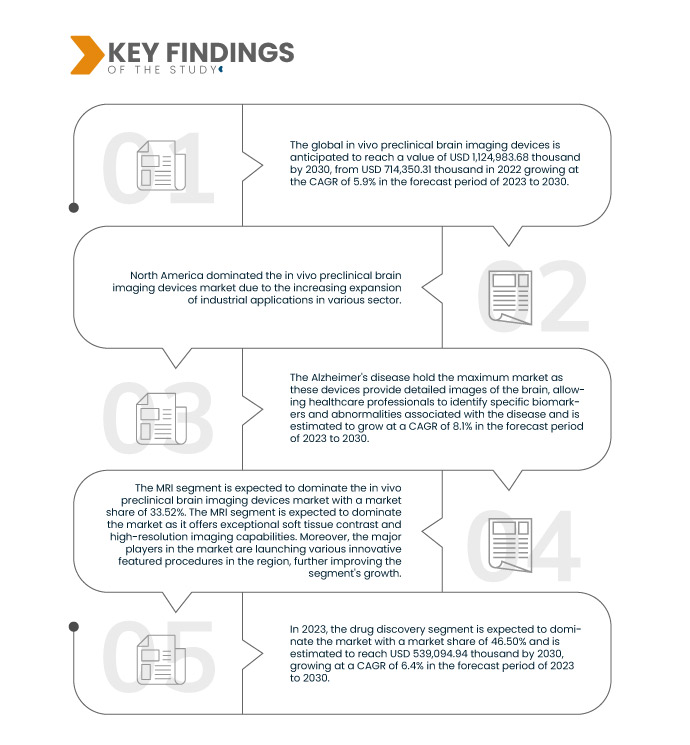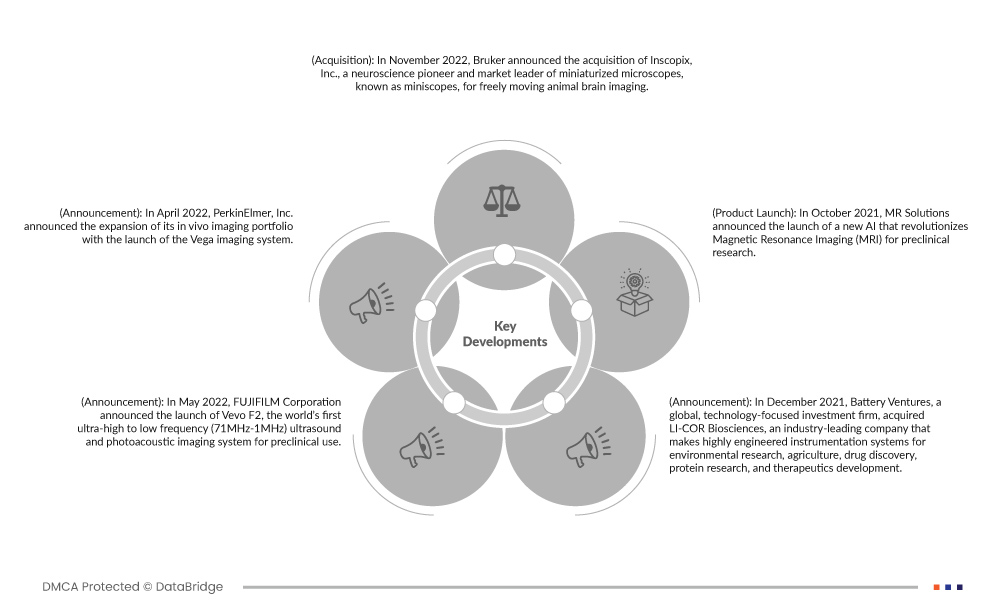The growing prevalence of neurological disorders, such as Alzheimer’s Disease, Parkinson's Disease, multiple sclerosis, and various neurodevelopmental disorders, has spurred heightened research efforts. Researchers are driven to better understand the underlying mechanisms, early detection, and potential treatments for these conditions.
There is a growing need for effective diagnostics, treatments, and interventions as the prevalence of neurological disorders continues to rise globally. In-vivo preclinical brain imaging devices are indispensable tools that contribute to a deeper understanding of these disorders and the development of innovative solutions, making them a vital component of the healthcare and research landscape.
Access Full Report @ https://www.databridgemarketresearch.com/reports/global-in-vivo-preclinical-brain-imaging-devices-market
Data Bridge Market Research analyses that the Global in Vivo Preclinical Brain Imaging Device Market is expected to grow with a CAGR of 5.9% in the forecast period from 2023 to 2030, and is expected to reach USD 1,124,983.68 thousand by 2030.
Key Findings of the Study
Advancements in Imaging Techniques Used in Brain Imaging
Advancements in imaging technologies have led to significantly improved spatial resolution and sensitivity in brain imaging. Higher-resolution images provide researchers with more detailed information about brain structures and functions. This improved clarity is essential for studying fine anatomical details and detecting subtle changes associated with neurological disorders or experimental treatments. Modern preclinical brain imaging devices often offer multi-modal capabilities, allowing researchers to combine multiple imaging techniques in a single study. For instance, combining magnetic resonance imaging (MRI) with positron emission tomography (PET) or single-photon emission computed tomography (SPECT) can provide complementary information about brain structure, metabolism, and function. This versatility enhances the depth and scope of preclinical research.
Advancements in functional brain imaging, such as functional MRI (fMRI) and PET, enable researchers to study brain activity in real time. This is crucial for understanding neural networks, cognitive processes, and how neurological disorders affect brain function. Functional imaging also plays a key role in evaluating the effectiveness of potential therapies. Dynamic imaging techniques, including dynamic contrast-enhanced MRI and dynamic PET, allow researchers to capture changes in brain physiology and function over time. These techniques are valuable for tracking disease progression and assessing the impact of interventions on dynamic processes such as blood flow, metabolism, and neurotransmitter activity.
Report Scope and Market Segmentation
|
Report Metric
|
Details
|
|
Forecast Period
|
2023 to 2030
|
|
Base Year
|
2022
|
|
Historic Years
|
2021 (Customizable to 2015 - 2020)
|
|
Quantitative Units
|
Revenue in USD Thousand
|
|
Segments Covered
|
Imaging Modality Type (MRI, PET/SPECT, CT, Optical Miniscopes, 2 Photon Confocal, US, NIR Fluorescence, OCT, Bioluminescence, and Others), Application (Drug Discovery, Disease Characterization, and Toxicology), Therapeutic Area (Alzheimer’s Disease, Parkinson's Disease, Oncology, and Other Therapeutic Areas), Biological Variable (BOLD, Oxygenation, Blood Flow, Microvessels, Neuronal Activity, and Soft Tissue), Temporal Format of Use (Under an Hour, Many Hours, and Longitudinal), End User (Pharma-Inhouse, CRO, Academia, and Others)
|
|
Countries Covered
|
U.S., Canada, Mexico, Germany, France, U.K., Italy, Spain, Russia, Turkey, Belgium, Netherlands, Switzerland, and Rest of Europe, Japan, China, South Korea, India, Australia, Singapore, Thailand, Malaysia, Indonesia, Philippines, Rest of Asia-Pacific, Brazil, Argentina, Rest of South America, South Africa, Saudi Arabia, U.A.E., Egypt, Israel, and Rest of Middle East and Africa
|
|
Market Players Covered
|
PerkinElmer Inc. (U.S.), FUJIFILM Corporation (Japan), Mediso Ltd. (Hungary), Spectral Instruments Imaging (U.S.), Hologic, Inc. (U.S.), MR Solutions (U.K.), Charles River Laboratories (U.S.), Aspect Imaging Ltd. (U.S.), Bruker (Germany), Trifol Imaging (U.S.), MILabs B.V. (Netherlands), L_-COR, Inc, (U.S.), Cubresa Inc (Canada), Bethold Technologies GmbH & Co. KG (Germany), AI4R (France), Mitenyi Biotec (Germany), among others
|
|
Data Points Covered in the Report
|
In addition to the insights on market scenarios such as market value, growth rate, segmentation, geographical coverage, and major players, the market reports curated by the Data Bridge Market Research also include depth expert analysis, patient epidemiology, pipeline analysis, pricing analysis, and regulatory framework.
|
Segment Analysis
The global in vivo preclinical brain imaging devices market is segmented into six notable segments based on imaging modality type, application, therapeutic area, biological variable, temporal format of use, and end user.
- On the basis of imaging modality type, the market is segmented into MRI, PET/SPECT, CT, optical miniscopes, 2 photon confocal, US, NIR fluorescence, OCT, bioluminescence, and others.
In 2023, the MRI segment is expected to dominate the global in vivo preclinical brain imaging devices market
In 2023, the MRI segment is expected to dominate the market with a market share of 33.52% as it offers exceptional soft tissue contrast and high-resolution imaging capabilities.
- On the basis of application, the market is segmented into drug discovery, disease characterization, and toxicology.
In 2023, the drug discovery segment is expected to dominate the global in vivo preclinical brain imaging devices market
In 2023, the drug discovery segment is expected to dominate the market with a market share of 46.50% due to a rise in technology advancement.
- On the basis of therapeutic area, the market is segmented into Alzheimer's disease, Parkinson's disease, oncology, and other therapeutic areas. In 2023, the Alzheimer's disease segment is expected to dominate the market with a market share of 43.12%.
- On the basis of biological variable, the market is segmented into BOLD, oxygenation, blood flow. microvessels, neuronal activity, and soft tissue. In 2023, the BOLD segment is expected to dominate the market with a market share of 40.25%.
- On the basis of temporal format of use, the market is segmented into under an hour, many hours, and longitudinal. In 2023, the under an hour segment is expected to dominate the market with a market share of 67.98%.
- On the basis of end user, the market is segmented into pharma-inhouse, CRO, academia, and others. In 2023, the pharma-inhouse segment is expected to dominate the market with a market share of 49.85%.
Major Players
Data Bridge Market Research recognizes the following companies as the market players in the market include PerkinElmer Inc. (U.S.), FUJIFILM Corporation (Japan), Charles River Laboratories (U.S.), Bruker (Germany), and Mitenyi Biotec (Germany) among others.
Market Developments
- In November 2022, Bruker announced the acquisition of Inscopix, Inc., a neuroscience pioneer and market leader of miniaturized microscopes, known as miniscopes, for freely moving animal brain imaging. This helped the organization develop more revenue.
- In May 2022, FUJIFILM Corporation announced the launch of Vevo F2, the world’s first ultra-high to low frequency (71MHz-1MHz) ultrasound and photoacoustic imaging system for preclinical use. The Vevo F2 features HD image processing technology and introduces a completely new signal pathway – from transducer to display screen. This enabled better image clarity, and when combined with multi-line processing, delivered significantly improved frame rates over earlier generation platforms.
- In April 2022, PerkinElmer, Inc. announced the expansion of its in vivo imaging portfolio with the launch of the Vega imaging system. This increased the company's product portfolio and overall revenue.
- In December 2021, Battery Ventures, a global, technology-focused investment firm, acquired LI-COR Biosciences, an industry-leading company that makes highly engineered instrumentation systems for environmental research, agriculture, drug discovery, protein research, and therapeutics development.
- In October 2021, MR Solutions announced the launch of a new AI that revolutionizes Magnetic Resonance Imaging (MRI) for preclinical research. This helped the organization develop more revenue.
Regional Analysis
Geographically, the countries covered in the market report are U.S., Canada, Mexico, Germany, France, U.K., Italy, Spain, Russia, Turkey, Belgium, Netherlands, Switzerland, and Rest of Europe, Japan, China, South Korea, India, Australia, Singapore, Thailand, Malaysia, Indonesia, Philippines, Rest of Asia-Pacific, Brazil, Argentina, Rest of South America, South Africa, Saudi Arabia, U.A.E., Egypt, Israel, and Rest of Middle East and Africa.
As per Data Bridge Market Research analysis:
North America is the fastest-growing and dominant region in the global in vivo preclinical brain imaging device market during the forecast period 2023 - 2030
North America is expected to dominate the global in vivo preclinical brain imaging device market because of the higher level of investments by various manufacturers and increasing technological advancements in the region. North America will continue to dominate the global in vivo preclinical brain imaging device market in terms of market share and market revenue and will continue to flourish its dominance during the forecast period. North America is estimated to be the fastest-growing region in the global in vivo preclinical brain imaging device market during the forecast period 2023 to 2030. This is due to the growing adoption of advanced technology and the launch of new products in this region.
For more detailed information about the global in vivo preclinical brain imaging device market report, click here – https://www.databridgemarketresearch.com/reports/global-in-vivo-preclinical-brain-imaging-devices-market












